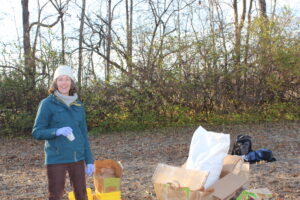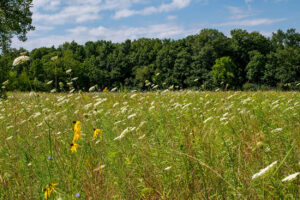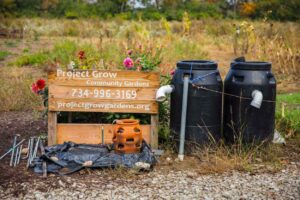We consider each and every one of our preserves special. Each one has something unique, and the Lloyd and Mabel Johnson Preserve is no exception. When Legacy acquired the Johnson Preserve in 2007, it was our only public preserve with both natural and agricultural lands. In addition to regionally important natural communities including buttonbush swamp and southern hardwood swamp, it was also home to 18 acres of farmland that had been under cultivation since the nineteenth century. It was that agricultural land that made the Johnson Preserve different from Legacy’s other preserves, and while that area has since been transformed, it is the same swath of land that continues to make the Preserve unique today.
During the summer of 2016, Legacy staff began implementing a comprehensive plan to restore the farm fields to a more natural land cover. With financial support from the Natural Resource Conservation Service’s Conservation Reserve Program (CRP)—a program designed to help landowners remove sensitive land from agricultural production by planting long-lived native grass and wildflowers to reduce soil erosion, improve water quality, and provide wildlife habitat—Legacy is converting fifteen acres of the original eighteen acres of agricultural land into a native wet-mesic prairie community. It is Legacy’s first large-scale ecological restoration project and it will serve as a demonstration for farmers or other landowners who may be interested in returning parts of their land to a more natural state, especially those hoping to utilize CRP to do so.
The remaining three acres of the original 18 were devoted to on-going projects managed through two community partnerships: one with Eastern Michigan University (EMU) and another with Project Grow Community Gardens.

Dr. Emily Grman, EMU professor, prepares for a prairie restoration experiment on the Johnson Preserve
In 2016, Legacy and EMU formalized a partnership allowing Assistant Professor Emily Grman to conduct a long-term prairie restoration experiment with a plot of the Preserve’s retired farm field. Dr. Grman is examining weed suppression, native biodiversity, and performance of various seed mixes. The project provides hands-on learning for EMU students and will contribute to the science of grassland restoration in southern Michigan.
Also, in the fall of 2016, Project Grow Community Gardens, a nonprofit that provides community garden space, installed test garden plots near the Preserve’s parking area. The plots were designed to determine infrastructure needs for their long-term viability. The preserve’s heavy clay soil is hard to work with, and Project Grow is testing the effectiveness of amending with composted leaves. If the test plots prove viable, the program could expand and provide garden plots to Ypsilanti and Ann Arbor residents.
The trail system on the preserve allows visitors to view all stages of the restoration effort and its associated partnership projects. The next time you’re at the Johnson Preserve enjoying a family outing or taking a quick stroll to unwind after a long day of work, be sure to soak in the traditional preserve hike highlights, and remember to look out for Legacy’s unique collaborations with community partners within the prairie restoration area.
Click here for more information about the Lloyd and Mabel Johnson Preserve and to download a Preserve brochure.




 RSS Feed
RSS Feed